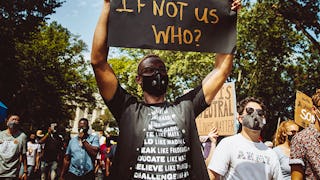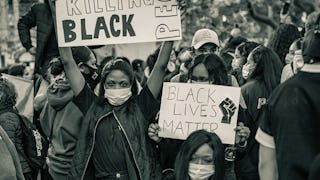In this course, students will develop a greater understanding of Asian American history and identities, explore the problematic history of anti-Asian discrimination in the US, and develop skill sets that they can use to address anti-Asian hate and violence in their community. Target learners include students interested in Asian American history and Anti-Racism, but also any learner interested in creating more inclusive communities for AAPI Americans and stopping racism, hate, and violence in their community.


您将学到什么
Define anti-asian racism and its history in the US
Recognize the diversity of AAPI cultures, perspectives, and experiences
Identify bias, discrimination, and racism in various spaces
Develop a skill set for responding to anti-asian racism
您将获得的技能
要了解的详细信息

添加到您的领英档案
了解顶级公司的员工如何掌握热门技能

该课程共有4个模块
This course is designed to dispel false narratives and negative associations with Covid-19 by identifying the roots of Anti-Asian hate and violence in the US and by giving learners a picture of Asian American history and Identity in the US that reflects the diversity, complexity, and beauty of Asian American identity. As a project designed to counteract racist associations amplified by Covid-19 that serve as the foundations for hate speech and hateful acts of violence, this course joins a growing social movement seeking to raise awareness of Anti-Asian cultural sentiments and to give learners an anti-racist toolkit and workable historical knowledge base through which they can take an active role in making their communities safer and more inclusive for Asian Americans. This week is focused on understanding the diversity of Asian American identity and developing terminology to understand anti-racism.
涵盖的内容
4个视频14篇阅读材料3个讨论话题
This week’s lessons explore some of the major themes in Asian American history. The assigned materials will introduce learners to the myriad global forces that brought Asians and Pacific Islanders (AAPI) to the United States at different historical periods. Asians and Pacific Islanders were sought after by American business owners as sources of labor on plantations, farms, and railways. At the same time, they were excluded through formal and informal means from full participation in civic life. American overseas wars and imperial activities also pulled AAPIs deeper into the orbit of American influence. Still, many AAPI immigrants maintained close ties to Asia long after they had settled permanently in the US.
涵盖的内容
4个视频10篇阅读材料1个讨论话题
In the wake of the Covid-19 pandemic there has been a marked increase in Anti-Asian hate and violence in the US. Unfortunately, the linking of Asian and other immigrant groups to disease has a long history in the US, of which the COVID 19 pandemic is only the most recent example. Rather than seeing the rise of Anti-Asian hate and violence as only a result of scapegoating Asian people for the deadly disease, here we examine the ways that the pandemic exacerbated negative racial sentiments that have deep roots in American culture. From racialized figures like Dr. Fu Manchu, conjured in 20th century to express fears of Asian peoples and support ideologies of White Supremacy, to stereotypes such as the Asian “Tiger Mom” and the myth of Asians as a “Model Minority,” to the contemporary racist language of Covid 19 as the “Kung Flu,” popular culture and media have played an outsized role in representing and MIS representing Asian peoples and cultures. In this section we examine the link between racialized metaphors of contagion during Covid-19 and the rise in Anti- Asian violence. We then examine the role that popular culture and media have played in reproducing stereotypes about Asian people and the disproportionate lack of diverse, Asian-centered, non-stereotypical narratives, depictions, and roles for Asians in popular culture.
涵盖的内容
3个视频5篇阅读材料4个讨论话题
We will conclude the course with a video, peer review assignment, and additional information you can refer to.
涵盖的内容
1个视频1篇阅读材料1次同伴评审
从 History 浏览更多内容
 状态:免费试用
状态:免费试用University of Colorado Boulder
 状态:免费试用
状态:免费试用University of Colorado Boulder
 状态:免费试用
状态:免费试用University of Colorado Boulder
 状态:预览
状态:预览University of Illinois Urbana-Champaign
人们为什么选择 Coursera 来帮助自己实现职业发展




常见问题
To access the course materials, assignments and to earn a Certificate, you will need to purchase the Certificate experience when you enroll in a course. You can try a Free Trial instead, or apply for Financial Aid. The course may offer 'Full Course, No Certificate' instead. This option lets you see all course materials, submit required assessments, and get a final grade. This also means that you will not be able to purchase a Certificate experience.
When you purchase a Certificate you get access to all course materials, including graded assignments. Upon completing the course, your electronic Certificate will be added to your Accomplishments page - from there, you can print your Certificate or add it to your LinkedIn profile.
Yes. In select learning programs, you can apply for financial aid or a scholarship if you can’t afford the enrollment fee. If fin aid or scholarship is available for your learning program selection, you’ll find a link to apply on the description page.
更多问题
提供助学金,
¹ 本课程的部分作业采用 AI 评分。对于这些作业,将根据 Coursera 隐私声明使用您的数据。





